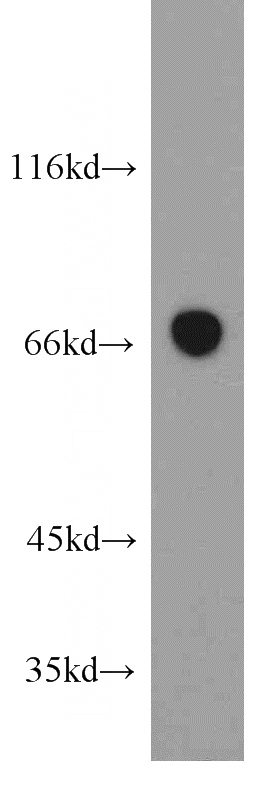-
Product Name
SESN1 antibody
- Documents
-
Description
SESN1 Rabbit Polyclonal antibody. Positive WB detected in human skeletal muscle tissue, human testis tissue, mouse liver tissue. Observed molecular weight by Western-blot: 66-68 kDa
-
Tested applications
ELISA, WB
-
Species reactivity
Human,Mouse,Rat; other species not tested.
-
Alternative names
p53 regulated protein PA26 antibody; PA26 antibody; RP11 787I22.1 antibody; SESN1 antibody; SEST1 antibody; sestrin 1 antibody
-
Isotype
Rabbit IgG
-
Preparation
This antibody was obtained by immunization of SESN1 recombinant protein (Accession Number: NM_014454). Purification method: Antigen affinity purified.
-
Clonality
Polyclonal
-
Formulation
PBS with 0.1% sodium azide and 50% glycerol pH 7.3.
-
Storage instructions
Store at -20℃. DO NOT ALIQUOT
-
Applications
Recommended Dilution:
WB: 1:200-1:2000
-
Validations

human skeletal muscle tissue were subjected to SDS PAGE followed by western blot with Catalog No:115214(SESN1 antibody) at dilution of 1:500
-
Background
Sestrins, including sestrin-1 (PA26), sestrin-2 (Hi95), and sestrin-3, are 48 to 65 kDa cystein sulfinyl reductases and they modulate peroxide signaling and antioxidant defense. These proteins selectively reduce or repair hyperoxidized forms of typical 2-Cys peroxiredoxins within eukaryotes. Expression of these proteins is regulated by p53, a tumor suppressor protein. Sestrin 1 is implicated in the inhibition of cell growth. It is approximately a 66kDa protein in humans (551 amino acids).
-
References
- Tao R, Xiong X, Liangpunsakul S, Dong XC. Sestrin 3 protein enhances hepatic insulin sensitivity by direct activation of the mTORC2-Akt signaling. Diabetes. 64(4):1211-23. 2015.
Related Products / Services
Please note: All products are "FOR RESEARCH USE ONLY AND ARE NOT INTENDED FOR DIAGNOSTIC OR THERAPEUTIC USE"
